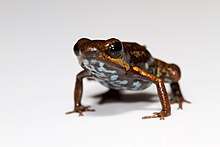Blue-bellied poison frog
The blue-bellied poison frog or bluebelly poison frog (Andinobates minutus) is a species of frogs in the family Dendrobatidae.
| Blue-bellied poison frog | |
|---|---|
 | |
| Scientific classification | |
| Kingdom: | Animalia |
| Phylum: | Chordata |
| Class: | Amphibia |
| Order: | Anura |
| Family: | Dendrobatidae |
| Genus: | Andinobates |
| Species: | A. minutus |
| Binomial name | |
| Andinobates minutus (Shreve, 1935) | |
| Synonyms | |
|
Dendrobates minutus minutus Shreve, 1935 | |
Dart-poison frogs (Dendrobatidae) form the most diverse group of diurnal frogs in the Neotropics, diminutive animals that possess aposematic coloration and toxic skin secretions.[2][3]
Taxonomic problems among these frogs are often caused by color polymorphisms which are common within and between species; thus molecular genetics, bioacoustics, ecological and behavioral data have been applied recently to solve many taxonomic problem within the family.[4][5]
It is found in Colombia and Panama.[6] The range of this species within Panama and Colombia goes from Panama (within El Valle and Cerro Campana, in the central areas of the country and the eastern lowlands and cordilleras), south to Colombia (south to Rio Saija). It occurs below 1,000m, generally even lower.[7] Its natural habitats are tropical moist lowland forests. It is a locally abundant, terrestrial species.[1] As the scientific name suggests, it is a small frog, only 13–16 mm (0.51–0.63 in) in snout–vent length.[8] The eggs are deposited in leaf-litter; the male carries the tadpoles to bromeliads, where they complete their development.[1] It is not found in degraded habitats, but does occur in mature secondary forests.[7]
Andinobates minutus have a specialist diet, with preference for Acari (mites), Formicidae (ants), Collembola (springtails), and Holometabolous larvae.[9]
It is threatened by habitat loss (deforestation) and pollution. In specific, the major threats for this species are deforestation for agricultural development, illegal crops, logging, human settlement, and pollution from resulting from the spraying of illegal crops.[7] This species is not collected for pet trade, unlike many other poison frogs.[1]
References
- Solís, F.; Ibáñez, R.; Jaramillo, C.; Fuenmayor, Q.; Jungfer, K.-H.; Bolívar, W. (2004). "Andinobates minutus". The IUCN Red List of Threatened Species. 2004: e.T55192A11256063. doi:10.2305/IUCN.UK.2004.RLTS.T55192A11256063.en.
- Daly, John W.; Myers, Charles W.; Whittaker, Noel (1987). "Further classification of skin alkaloids from neotropical poison frogs (dendrobatidae), with a general survey of toxic/noxious substances in the amphibia". Toxicon. 25 (10): 1023–1095. doi:10.1016/0041-0101(87)90265-0. ISSN 0041-0101. PMID 3321567.
- Grant, Taran; Frost, Darrel R.; Caldwell, Janalee P.; Gagliardo, Ron; Haddad, Célio F.b.; Kok, Philippe J.r.; Means, D. Bruce; Noonan, Brice P.; Schargel, Walter E.; Wheeler, Ward C. (15 August 2006). "Phylogenetic systematics of dart-poison frogs and their relatives (amphibia: athesphatanura: dendrobatidae)". Bulletin of the American Museum of Natural History. 299: 1–262. CiteSeerX 10.1.1.693.8392. doi:10.1206/0003-0090(2006)299[1:PSODFA]2.0.CO;2. ISSN 0003-0090.
- Silverstone, P (1975). "A revision of the poison–arrow frogs of the genus Dendrobates Wagler". Natural History Museum of Los Angeles County Science Bulletin. 21: 1–55.
- Brown, J.L; Twomey, E; Amézquita, A; Barbosa De Souza, M; Caldwell, J.P; Lötters, S; Von May, R; Melo-Sampaio, P.R; Mejía- Vargas, D; Perez-Peña, P; Pepper, M; Poelman, E.H; Sanchez-Rodriguez, M; Summers, K (2011). "A taxonomic revision of the Neotropical poison frog genus Ranitomeya (Amphibia: Dendrobatidae)" (PDF). Zootaxa. 3083: 1–120. doi:10.11646/zootaxa.3083.1.1. Archived from the original (PDF) on 5 March 2016. Retrieved 27 April 2018.
- Frost, Darrel R. (2014). "Andinobates minutus (Shreve, 1935)". Amphibian Species of the World: an Online Reference. Version 6.0. American Museum of Natural History. Retrieved 13 September 2014.
- "Andinobates minutus (Blue-bellied Poison-arrow Frog, Blue-bellied Poison Frog, Bluebelly Poison Frog)". IUCN Red List of Threatened Species.
- Vitt, Laurie J.; Caldwell, Janalee P. (2014). Herpetology: An Introductory Biology of Amphibians and Reptiles (4th ed.). Academic Press. p. 489.
- Agudelo-Cantero, Gustavo A.; Castaño-Valencia, R. Santiago; Castro-Herrera, Fernando; Fierro-Pérez, Leonardo; Asencio-Santofimio, Helberg (1 September 2015). "Diet of the Blue-Bellied Poison Frog Andinobates minutus (Anura: Dendrobatidae) in Two Populations from the Colombian Pacific". Journal of Herpetology. 49 (3): 452–461. doi:10.1670/13-202.
